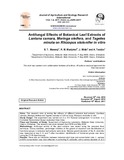Please use this identifier to cite or link to this item:
https://cris.library.msu.ac.zw//handle/11408/3020Full metadata record
| DC Field | Value | Language |
|---|---|---|
| dc.contributor.author | Manenji, B.T. | - |
| dc.contributor.author | Mudyiwa, R.M. | - |
| dc.contributor.author | Midzi, R | - |
| dc.contributor.author | Tsodzo, A. | - |
| dc.date.accessioned | 2018-05-06T10:29:08Z | - |
| dc.date.available | 2018-05-06T10:29:08Z | - |
| dc.date.issued | 2017 | - |
| dc.identifier.issn | 2394 - 1073 | - |
| dc.identifier.uri | http://www.sciencedomain.org/abstract/18150 | - |
| dc.identifier.uri | http://hdl.handle.net/11408/3020 | - |
| dc.description.abstract | Aims: This research aims at testing the efficacy of different botanical leaf extracts, (Lantana camara, Moringa oleifera and Tagetes minuta) on soft rot fungi, Rhizopus stolonifer in vitro. Study Design: The experiment was carried out in a 3*2 Factorial arrangement +2 controls in a Complete Randomized Design replicated three times. Place and Duration of Study: Department of Agronomy Laboratory, Midlands State University, Gweru, Zimbabwe. The research was done between April 2016 and May 2016. Methodology: Antifungal activity of the plant extracts was tested using the poisoned food technique. Colony diameter, percentage inhibition of the growth of mycelium and identification of functional groups in botanical leaf extracts were done. Mycelia growth diameter of the R. stolonifer was measured at day 3, 5, and 7 after inoculation. Identification of functional groups was done using the FT-IR Spectroscopy. Results: There was an interaction between botanical plant type and concentration rate. L. camara at 60% concentration was most effective in controlling R. stolonifer, with a colony diameter of (4.3 cm) and an inhibition percentage of (48%). M. oleifera and T. minuta at 30% concentration gave the lowest colony growth inhibition of 30% and 31% respectively. FT-IR Spectroscopy confirmed the presence of phenols, alkanes, alkenes, anhydride and alkyl halide in all the three extracts. Amines were only detected in L. camara extract. Conclusion: The data obtained provide additional information in support of plant extracts for control of R. stolonifer, though the efficacy of plant extracts tested still remain below that of the synthetic pesticide, (control). As the concentration of the extracts increased, the effectiveness of the extracts also increased. | en_US |
| dc.language.iso | en | en_US |
| dc.publisher | SCIENCEDOMAIN International | en_US |
| dc.relation.ispartofseries | International Journal of Plant & Soil Science;Vol. 11,No. 2: p. 1-8 | - |
| dc.subject | Botanical leaf extracts | en_US |
| dc.subject | Rhizopus stolonifer | en_US |
| dc.subject | FT-IR Spectroscopy. | en_US |
| dc.title | Antifungal effects of botanical leaf extracts of lantana camara, moringa oleifera, and tagetes minuta on rhizopus stolonifer in vitro | en_US |
| dc.type | Article | en_US |
| item.openairecristype | http://purl.org/coar/resource_type/c_18cf | - |
| item.languageiso639-1 | en | - |
| item.cerifentitytype | Publications | - |
| item.openairetype | Article | - |
| item.fulltext | With Fulltext | - |
| item.grantfulltext | open | - |
| Appears in Collections: | Research Papers | |
Files in This Item:
| File | Description | Size | Format | |
|---|---|---|---|---|
| Mudyiwa1122016JAERI28371.pdf | Full Text | 276 kB | Adobe PDF |  View/Open |
Page view(s)
106
checked on Nov 6, 2025
Download(s)
48
checked on Nov 6, 2025
Google ScholarTM
Check
Items in MSUIR are protected by copyright, with all rights reserved, unless otherwise indicated.



